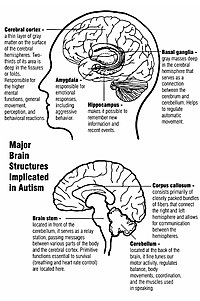
Photo from wikipedia
The crisis of pulmonary arterial hypertension (PAH) in meconium aspiration syndrome is a well known entity. Its rapid diagnosis can be extremely challenging in a newborn in the absence of… Click to show full abstract
The crisis of pulmonary arterial hypertension (PAH) in meconium aspiration syndrome is a well known entity. Its rapid diagnosis can be extremely challenging in a newborn in the absence of promptly echocardiographic diagnosis, but saviour. Persistent cyanosis can be attributed to several causes in such a patient. We present the case of a newborn, transferred soon after birth towards a level III maternity with meconium aspiration syndrome. Evolution of the newborn was initially extremely serious, but with significant improvement within 12 hours. Later on, recurrent episodes of generalised cyanosis followed. Initial echocardiography performed during such a cyanosis crisis revealed an exclusively right-to-left shunt, at the level of both persistent ductus arteriosus and atrial septal defect suggesting impressive PAH. After exiting the crisis, which coincided with blood pressure (BP) measurement in all limbs, shunt rapidly became left-to-right in both communications. Phosphodiesterase inhibitor treatment proved highly effective. The patient showed normal levels of pulmonary pressure, at discharge. Conclusion This case highlights the importance of echocardiographic diagnosis: accurately, quickly especially in particularly severe cases for guiding therapy. Ultrasound diagnosis may surprise reversal of the shunts under the influence of simultaneous measurement of BP in all limbs and the influence of concomitant phosphodieterasis inhibitors treatment over the pulmonary blood pressure. The peculiarity of the case is the decreasing values of PAH in the early hours of treatment. This case outline the difference between PAH and a PAH crisis in meconium aspiration syndrome.
Journal Title: Archives of Disease in Childhood
Year Published: 2017
Link to full text (if available)
Share on Social Media: Sign Up to like & get
recommendations!